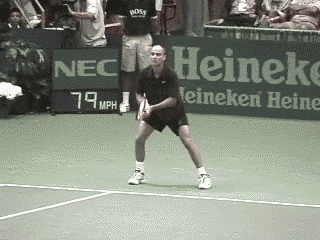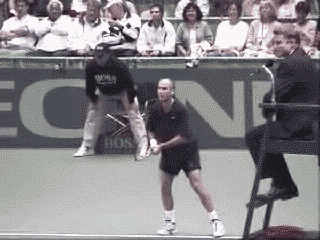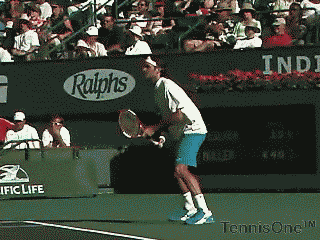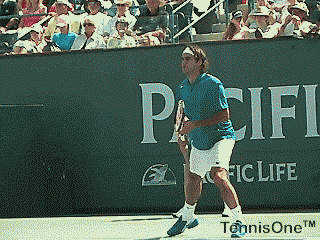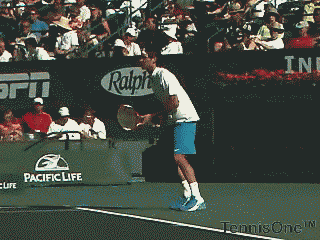|
TennisOne Lessons Return of Serve – Old School Jim McLennan The return of serve may be the stroke practiced least (recreationally or professionally) that bears the greatest impact on a match. In 1998 Staff Graf trained at Fremont Hills in preparation for the Stanford WTA tournament. I had the rare opportunity to witness this great champion first hand. Two practice sessions per day, two hours per session, jam packed with furious and glorious hitting. Trading groundies, working on patterns, approaches, passes, volleys, and more. Rarely, however, any serve and return work. That week she lost in the finals to Lindsay Davenport 6-4, 6-7, 6-3, and though the match was dreadfully close, Staff remarked afterwards that her return of serve had unfortunately told the tale that day. Though this is certainly anecdotal evidence, I see the same thing with the high level junior practice - excellent pace and length on their ground games, but somehow the return of serve rarely practiced, and something uncertain about the technique and tactics of this crucial shot. It is certainly no coincidence that if the greats often ignore this part of the game, the same would occur at the competitive recreational level. Compare the last two matches between Djokovic and Federer at the 2007 US Open finals and the 2008 Australian Open semifinals. Both quite close with much ebb and flow during the points: so many balls either on or barely beyond the line.At the US Open, Federer led Djokovic on total return points won 36% to 27%. At the Australian Open Djokovic reversed form, leading with 39% compared to 33% on total return points won. Yes, there are other factors, including length of rally, who attacks, who defends, and so much more. But at the end of the day the winner will generally be the player who gets the return of the first serve in play, and who makes something happen against suspect second serves. So many of our Big Banger Americans over swing and return serve with regrettable inconsistency. They (as well as you and I) might be improved by taking a step backwards in time to some of the Old School return of serve techniques. Namely, borrowing pace on the return of the first serve. Step in and make something happen on the return of the second serve. And finally, if staying back, return crosscourt, if coming in, return up the line. Simple rules, though rarely observed at any level. Now to Some Practical Advice
A good server will often use spin to the corners to move an opponent out of position. And when “cornered" the receivers first problem, assuming they do in fact return the serve, is to recover back to the center of the baseline to get into the point. Further, the nuances of the sidespin and kick serves are used to improve cornering tactics against the receiver. Job One – Wait for the return with one foot ever so slightly in the alley. Arthur Ashe used this tactic years ago – essentially inviting the server to play down the middle. But when the server takes this bait, the receiver is now “centered” to begin the rally. Fairly simple, and works much more often than you might imagine. In the following example Agassi positions out wide in the deuce court, scrambles quickly to for a backhand return, but once hit Andre he is now perfectly centered for the ensuing rally. Job Two – Pay very close attention to patterns of serve placement. Too often in junior or adult classes, a server will swing two or three excellent serves to the same location in either the deuce or ad court. But when I ask the receiver if they have identified the opponent’s favorite serve, rarely do I get a simple answer. If I then suggest they position out wider to combat a particular serve the reply will be, “What if they ace me up the middle?” Well for better or worse the server must prove to you he has the ability to place the ball in all four corners of the two service boxes, but often he does not, and a wily receiver who gets on to these patterns will soon cover, if not wait, for the predictable serves. And when it comes to reading and anticipating service placement, none appear better than Roger Federer, who is aced far less than other players (especially on the grass at Wimbledon).
Job Three – Pay very close attention to patterns of serves following double faults. Many years ago I heard Stan Smith speak to a group of coaches about his “playing days.” And more than anything else, my personal take-away was his comment about winning three points in a row. Stan felt that the winner of any match was also the player who had won the most three in a row series of points, indicating dominance over the opponent. When Stan had won two in a row, he worked even harder to win that third point. And of equal if not greater importance, when he had lost two in a row he fought like the dickens to reverse form and capture the next point. Now consider the server who double faults, and then misses the subsequent first serve – assuming they would not care to deliver consecutive double faults they generally let up on that next second serve. The aggressive receiver knows this is coming, steps in and makes something happen, working always to apply more and more pressure against the second serve. And if per chance you receive two consecutive double faults, my recommendation would be to step in and attack the next first serve you receive. Servers may from time to time hit vulnerable patches, pay attention to this and attack appropriately. Agassi, who was both consistent against first serves and deadly with his return of second serves, often moved well inside the baseline to attack a short second serve.
Job Four - Borrow pace against big first serves. The modern game appears more and more to be about racquet speed – the guys and gals take pretty good cuts at the ball. But if and when the server delivers a big well placed first serve, the trick is to use the incoming pace, “borrow it” and simply block the ball back into play. When Federer blitzed Andy Roddick at the 2007 Australian Open, at one stage winning 10 games in a row (yes breaking Andy five consecutive games), Federer was not stroking huge winners against A-Rods first serve, just borrowing pace, blocking the ball, and getting into the point. Watch in the following example how Roger simply blocks the forehand return of the first serve in the deuce court. Nothing fancy, just a short and simple stroke, then he recovers quickly to get into himself the point. He applies pressure in this instance simply by getting into the point. Job Five – Make something happen when returning second serves. Here, patterns of play enter the picture. Either drivie the return deep into the corner or chip and charge and take control of the net. When driving the return of the second serve and remaining on the baseline, simply play the ball crosscourt. No real reason to return down the line, for in that case the net is high, the court is shorter, and most importantly, the recovery footwork is magnified. In the second video on the right, from the ad court, note how quickly Federer steps around his backhand for a big inside out forehand return. In this play he drove the ball crosscourt and positioned himself on the baseline. This offensive drive was not an approach and not necessarily a winner, but was driven heavily crosscourt deep into the opponent’s backhand corner. Approach Up the Line
On second serves, the other offensive action is to take the net. When approaching always play up the line, for in spite of the higher net and shorter court length, the volleying positioning becomes far easier. I remain perplexed at our American tendency (notably Andy Roddick) to approach crosscourt, and will need someone to convince me of the merits of this play. The Old School play was to move forward, play the ball flat or with under spin up the line, and knock off the volley into the open court. In the example (right) Roger moves forward in the deuce court, approached up the line with a heavy under spin backhand, and moved ever so slightly to cover the line for any likely passing attempt. Tremendous pressure accrues on the server when the receiver varies offensive tactics against the second serve. When we look at the best returners, in this case Agassi and Federer – the commonalities speak loudly. They appear to play from the hips rather than the arms and shoulders, their strokes are simple, the backswings compact (which is not to imply tight), and the incoming pace is used rather than fought against. Try it for yourself. Your comments are welcome. Let us know what you think about Jim McLennan's article by emailing us here at TennisOne.
|
||||||||||||||

